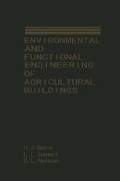Abstract
One of the most persistent and difficult problems in agricultural building design is the control of moisture. In livestock shelters large quantities of moisture in expired air must be removed continuously. In crop storage it may be necessary to remove excess moisture from the crop quickly to prevent spoilage, as with hay and grain; or it may be imperative, for the same reason, to hinder the escape of moisture, as in fruit and vegetable storage. We may find it necessary during the heating season to add moisture to the atmosphere in dwellings to improve comfort, or in other structures to reduce the amount of moisture in the air to prevent condensation on building surfaces.
Access this chapter
Tax calculation will be finalised at checkout
Purchases are for personal use only
Preview
Unable to display preview. Download preview PDF.
Bibliography
Arnold, J. H. (1933). The theory of the psychrometer. Physics 4, 255–262, 334–340.
ASHRAE (1981). “Handbook of Fundamentals.” American Society of Heating, Refrigerating and Air Conditioning Engineers, Atlanta, GA.
Dropkin, D. (1936). The deviation of the actual wet-bulb temperature from the temperature of adiabatic saturation. Cornell Univ. Eng. Exp. St. Bull. 23.
Goff, J. A. (1949). Standardization of thermodynamic properties of moist air. Trans. ASHVE 55: 462–464.
Henderson, S. M., and Perry, R. L. (1970). “Agricultural Process Engineering,” 2nd ed. Wiley and Sons, New York.
Marvin, C. F. (1941). Psychrometric tables for obtaining the vapor pressure, relative humidity, and temperature of the dew point. U.S. Dep. Commer., Weather Bur. 235.
Osborne, N. S., and Myers, C. H. (1954). A formula and tables for the pressure of saturated water vapor in the range 0 to 374°C. J. Res. Natl. Bur. Stand. 13(1). Res. Pap. 691.
Threlkeld, J. L. (1970). “Thermal Environmental Engineering,” 2nd ed. Prentice-Hall, Englewood Cliffs, NJ.
Weather Bureau (1953). Relative humidity-psychrometric tables (Celsius temperatures). U.S. Dep. Commer., Washington, D.C.
Wexler, A., and Brombacher, W. G. (1951). Methods of measuring humidity and testing hygrometers. U.S. Nat. Bur. Stand. Circ. 512.
Wile, D. D. (1944). Psychrometer in the frost zone. Refrig. Eng. 48: 291–303.
Author information
Authors and Affiliations
Rights and permissions
Copyright information
© 1988 Van Nostrand Reinhold Company Inc.
About this chapter
Cite this chapter
Barre, H.J., Sammet, L.L., Nelson, G.L. (1988). Psychrometrics. In: Environmental and Functional Engineering of Agricultural Buildings. Springer, Boston, MA. https://doi.org/10.1007/978-1-4684-1443-1_3
Download citation
DOI: https://doi.org/10.1007/978-1-4684-1443-1_3
Publisher Name: Springer, Boston, MA
Print ISBN: 978-1-4684-1445-5
Online ISBN: 978-1-4684-1443-1
eBook Packages: Springer Book Archive

